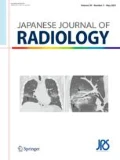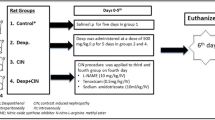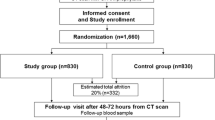Abstract
Purpose
To compare oral rehydration solution (ORS) with saline infusion for preventing contrast-induced nephropathy (CIN) in a rat model.
Materials and methods
Adult male Sprague–Dawley rats (310–360 g) received intravenous indomethacin (10 mg/kg), N G-nitro-l-arginine methyl ester (10 mg/kg), and iohexol (10 mL/kg) to induce acute contrast-induced renal injury (CIN group); control rats received saline only. For hydration, rats received either continuous infusion (20 mL/kg/h) of saline or three oral doses (20 mL/kg each) of ORS. Acute renal injury was evaluated by assaying urine collected for 24 h beginning 2 h before the contrast injection, evaluating blood taken 22 h after the contrast injection, and examining the kidneys histopathologically.
Results
Hydration with saline prevented only the contrast-induced increase in plasma creatinine, whereas ORS prevented deleterious changes in plasma creatinine, blood urea nitrogen, and creatinine clearance as well as in urinary protein, albumin, and N-acetyl-d-glucosaminidase concentrations. Histopathologic changes noted in the CIN group were diminished in both saline and ORS groups.
Conclusion
Both intravenous saline administration and oral hydration with ORS decreased the severity of CIN. Hydration with ORS was comparable to intravenous saline infusion in preventing CIN-associated abnormalities.


Similar content being viewed by others
References
Mckinstry DN, Rommel AJ, Sugerman AA. Pharmacokinetics, metabolism, and excretion of iopamidol in healthy subjects. Invest Radiol. 1984;19(Suppl):S171–4.
Edelson J, Shaw D, Palace G. Pharmacokinetics of iohexol, a new nonionic radiocontrast agent, in humans. J Pharm Sci. 1984;73:993–5.
Kitajima K, Maeda T, Watanabe S, Sugimura K. Recent issues in contrast-induced nephropathy. Int J Urol. 2011;18:686–90.
Wrobel W, Sinkiewicz W, Gordon M, Wozniak-Wisniewska A. Oral versus intravenous hydration and renal function in diabetic patients undergoing percutaneous coronary interventions. Kardiol Pol. 2010;68(9):1015–20.
Taylor AJ, Hotchkiss D, Morse RW, McCabe J. PREPARED: Preparation for Angiography in Renal Dysfunction: a randomized trial of inpatient vs outpatient hydration protocols for cardiac catheterization in mild-to-moderate renal dysfunction. Chest. 1998;114(6):1570–4.
Trivedi HS, Moore H, Nasr S, Aggarwal K, Agrawal A, Goel P, et al. A randomized prospective trial to assess the role of saline hydration on the development of contrast nephrotoxicity. Nephron Clin Pract. 2003;93(1):C29–34.
Ohno I, Hayashi H, Aonuma K, Horio M, Kashihara N, Okada H, et al. Guidelines on the use of iodinated contrast media in patients with kidney disease 2012: digest version: JSN, JRS, and JCS Joint Working Group. Clin Exp Nephrol. 2013;17:441–79.
Atia AN, Buchman AL. Oral rehydration solutions in non-cholera diarrhea: a review. Am J Gastroenterol. 2009;104:2596–604.
Agmon Y, Peleg H, Greenfeld Z, Rosen S, Brezis M. Nitric oxide and prostanoids protect the renal outer medulla from radiocontrast toxicity in the rat. J Clin Invest. 1994;94:1069–75.
Heyman SN, Rosen S, Rosenberger C. Renal parenchymal hypoxia, hypoxia adaptation, and the pathogenesis of radiocontrast nephropathy. Clin J Am Soc Nephrol. 2008;3(1):288–96.
Heyman SN, Rosen S, Khamaisi M, Idee JM, Rosenberger C. Reactive oxygen species and the pathogenesis of radiocontrast-induced nephropathy. Invest Radiol. 2010;45(4):188–95.
Duan SB, Wang YH, Liu FY, Xu XQ, Wang P, Zou Q, et al. The protective role of telmisartan against nephrotoxicity induced by X-ray contrast media in rat model. Acta Radiol. 2009;50(7):754–9.
Sochman J, Peregrin JH, Burgelova M, Kopkan L, Kramer HJ, Cervenka L. N-acetylcysteine attenuates iodine contrast agent-induced nephropathy in 5/6-nephrectomized rats. Kidney Blood Press Res. 2010;33(2):149–56.
Vaamonde CA, Bier RT, Papendick R, Alpert H, Gouvea W, Owens B, et al. Acute and chronic renal effects of radiocontrast in diabetic rats. Role of anesthesia and risk factors. Invest Radiol. 1989;24(3):206–18.
Andrade L, Campos SB, Seguro AC. Hypercholesterolemia aggravates radiocontrast nephrotoxicity: protective role of l-arginine. Kidney Int. 1998;53(6):1736–42.
Heyman SN, Brezis M, Reubinoff CA, Greenfeld Z, Lechene C, Epstein FH, et al. Acute renal failure with selective medullary injury in the rat. J Clin Invest. 1988;82(2):401–12.
Hansen PB, Jensen BL, Skott O. Chloride regulates afferent arteriolar contraction in response to depolarization. Hypertension. 1998;32:1066–70.
Akyuz S, Karaca M, Kemaloglu Oz T, Altay S, Gungor B, Yaylak B, et al. Efficacy of oral hydration in the prevention of contrast-induced acute kidney injury in patients undergoing coronary angiography or intervention. Nephron Clin Pract. 2014;28(1–2):95–100.
Miki S, Hino K, Kondo Y. Effects of oral rehydration solution on water and electrolytes absorption in rat small intestine. Clin Nutr. 2008;3(S1):170.
Acknowledgements
For experimental accomplishment, the author received technical support of Otsuka Pharmaceutical Factory, Inc which was the affiliation of the joint author. We thank Atsushi Tosaka (Otsuka Pharmaceutical Factory, Inc) for technical assistance in animal experiment.
Author information
Authors and Affiliations
Corresponding author
Ethics declarations
No grant concerned.
Conflict of interest
TM, RD, and RK declare that they have no conflict of interest. KH, SM, and GE are employees of the Otsuka Pharmaceutical Factory, Inc.
About this article
Cite this article
Matsunami, T., Hino, K., Dosho, R. et al. Efficacy of oral supplemental hydration for the prevention of contrast-induced nephropathy in rats. Jpn J Radiol 35, 190–196 (2017). https://doi.org/10.1007/s11604-017-0620-4
Received:
Accepted:
Published:
Issue Date:
DOI: https://doi.org/10.1007/s11604-017-0620-4




